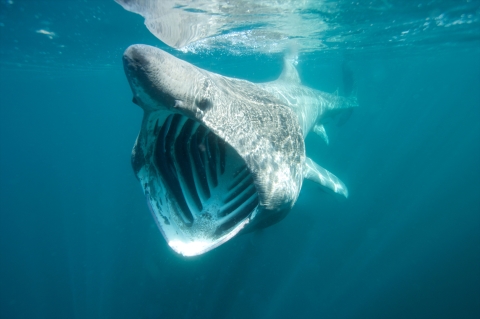Getting to know the UK's wonderful marine wildlife
Find out more about some of the species you could see when cruising in UK waters.
If the BBC’s new wildlife series on sharks has given you a whole new insight into the world of these amazing creatures, then you might be interested to know that the UK has over 20 species of resident sharks commonly found all year round including the Porbeagle and the Smallspotted Catshark, as well as a number of seasonal summer visitors such as the Blue shark and Shortfin Mako.
As a boater there is no better place to be than on the water if you want to catch a glimpse of the UK’s amazing marine wildlife, and as the cruising season gets underway with warmer weather and calmer seas, you are very likely to come across an array of creatures from seabirds, whales, dolphins and seals to sharks and turtles.

The largest fish in British waters (and the second largest fish in the world after the whale shark) is the impressive basking shark up to 12 metres in length and 6 tonnes in weight. It’s likely that you will spot it as it moves on its annual journey between May and September from the southwest tip of England up through Cardigan Bay, along the Isle of Man and Strangford Lough and on to the west coast of Scotland. As spring approaches, these gentle giants come to the surface to filter feed peacefully and slowly with their gargantuan mouths agape but it’s also during these times that they are at their most vulnerable from sightseers and boaters. Basking sharks are harmless so by all means take a look at a sensible distance but remember these wonderful creatures are protected by law.
The Smallspotted Catshark is the smallest shark found in the UK, rarely getting up to 100cm in length but distinguishable with its dark spotted body. In contrast the Porbeagle is strong and powerful and can grow up to 3.5 metres in length and over 135kgs in weight. Although alarmingly similar to the Great White in appearance, there’s nothing to fear as its diet of mackerel, pilchard and herring makes it disinterested in humans, though its speed and size alone makes it sensible to give it a wide berth!

Familiar sightings around the UK tend to be the curious and playful dolphins and seals. The most nimble species is the bottlenose dolphin, and often it will be this species that will join your passage on the bow wave. Large, stocky and strong and growing up to four metres, they are incredibly sleek in the water and can reach a swift 20 miles per hour. A smooth grey skin, white underside and short stubby beak might help you recognise it.
If you’re lucky enough to be accompanied by a playful pod this summer or any other marine wildlife, the rule of thumb is to steer a steady course at reduced speed and let them decide how long they wish to stay! Never chase or harass or go closer to get a better look as disturbance could land you on the wrong side of the law!

If you would like to read a little more about the variety of species found in UK waters, take a look at The Green Blue’s Green Marine Wildlife Guide.
For a printed version email info@thegreenblue.org.uk with your name and address. Alternatively venture into the digital version which is part of the RYA’s range of e-books by downloading the free ‘RYA Books’ app from iTunes and tapping ‘Catalogues & Brochures’.
https://itunes.apple.com/gb/app/rya-books/id451481707
For more information visit www.thegreenblue.org.uk
Contact UsArticle Published: May 27, 2015 15:14
Article Updated: May 28, 2015 11:19